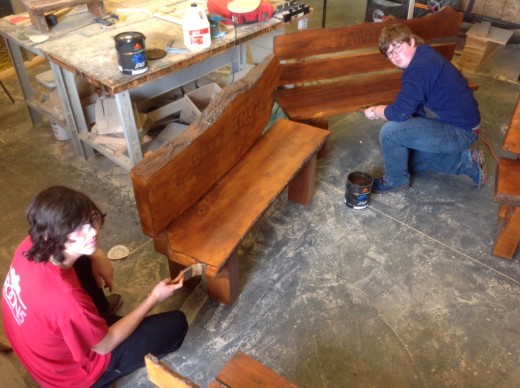Why High School Trades Training Matters
"Traditional" Courses?
I've been teaching high school for nearly a quarter century (GASP) and have stayed safely ensconced in the English and French departments in the high schools I've been privileged to teach at. I know my strengths, and staying in what has traditionally been termed "academic" courses is one of them. I'd no sooner be comfortable in a construction tech or cosmetology class than I would be, say, in flying to the moon, though I'm sure several of my friends would definitely have a good chuckle if they saw me attempting to teach such courses.
At any rate, during my time with my students, I've always noticed there are those kids who just tune right out anytime they are put into a "traditional" course. While our classrooms today look remarkably similar to the ones I once sat in as a student, there's a good lot going on that's different, ranging from vertical classrooms to SPARK breaks and so forth. Still, though, there are those kids for whom sitting and taking notes and doing oral practices and doing presentations just don't work, and I mean not even a little.
Enter the tech courses, the bastions of hope for kids who feel a little lost in traditional courses.
I remember in my own high school, courses like Industrial Education - which is what Construction Tech was once called in the 1980s - and Home Ec (now Hospitality or some other similar name) were believed to be the classes in which you received something of a break and you could relax a little. However, that's not so much the case now. These are courses that are giving a taste of what working in a trade could be like. Hospitality effectively prepares snacks for teacher staff meetings, or PD days for various departments. Construction or automotive tech allows students to learn the safety protocols in working in tech-oriented fields and actually get their hands dirty doing things they might do in the real world.
Then there's Cosmetology - the course that would have intimidated the absolute crap out of me. Cosmo gets a bad rap at times, I find, and that's because we tend to live by stereotypes. Until the last year or so, I had the view that Cosmo was a course where gorgeous girls spent all their time experimenting with different hairstyles and nail colors. As a woman who has never exactly been associated with the idea of being a "girly girl," this would be the course where I would very much feel like a fish out of water.
Boy, was I wrong, and I'm happy to say that.
One look at the curriculum for just one of the tech courses related to cosmetology and I was already thinking, "What the heck?"
"Describe the structure of the hair (e.g., medulla, cortex, papilla), skin (e.g., follicle, sebaceous gland, eccrine gland), and nails (e.g., eponychium, lunula, matrix, free edge)," reads one of the curriculum requirements on page 78 of the Grade 9 and 10 Ontario Technological Education curriculum guide. "Describe different characteristics of hair, skin, and nails that affect styling and treatment needs and options (e.g., porosity, elasticity, texture, density, growth patterns, protection, pigmentation)."
It's not for the faint of heart, and you have to be willing to work.
Fearlessly Exploring Hair And Beauty

Put A Kid In Trades, They May Just Thrive
There are kids in schools today for whom having to sit with a book, paper and a pen or pencil simply doesn't do it for them, and that's fine. However, if you gave that same student the opportunity to try a tech course, whether that's Construction Tech, Hospitality or Cosmetology, among others, and you might be surprised by the results.
You see, as a parent, I get the push to try and put your kid in university. I get it. As a child of the 1980s, that was the big deal - a university degree got you a job. Not every kid wants to spend four years hitting the books, though. By having students exploring the tech trades in high school, we are allowing our students the opportunity to have a taste of what could really work for them.
We're giving them a chance to gain real world experience. For the Construction Tech folks, they get to learn "the processes used to produce common construction materials (e.g., cutting and milling lumber and trim, gluing together the layers of plywood)" and to "use appropriate problem-solving processes and techniques to address various specific problems or challenges that may arise in connection with a construction project." These are tools that can help them when they become adults, not just with a career in the trades, but when they go on to own their own homes and so forth.
Hospitality students learn things like selecting "the appropriate tools or equipment for assigned tasks (e.g., knives, steamer, mixer, proofer, computer, washing machine, vacuum cleaner), and demonstrate the ability to use them safely and correctly" and "creating simple meals from various culinary traditions (e.g., French Canadian, Aboriginal, Italian, East Asian), with appropriate functional garnishes (e.g., lemon, parsley, radish flower; chocolate drizzle on dessert, berries on wild rice)."
Even looking at Communications Tech you can see the benefits to the students: "apply mathematical concepts and formulas as required to complete communications technology tasks (e.g., calculation of lighting ratios and exposures in photography and videography, timing of sequences in audio and video editing, calculation of paper and ink requirements in printing, determination of image resolution requirements for printing versus Internet use, calculation of file size)." While the math piece might have intimidated me, kids today are constantly looking at taking pictures and making videos in order to express themselves, with some even contemplating careers in photography and videography.
These are practical applications in courses that teach life skills, to an extent, and given the outcry from the public at large that today's kids are not learning the life skills they need to survive in the "real world," you can clearly see the benefits from these kids. They're walking out of these courses, looking a little prouder and walking a little taller, simply because they were given a chance to do something other than a "traditional" program of study.
The power of tech training is not to be denied, so it makes a lot of sense to involve kids in these sorts of experiences while they are in high school and can learn more not just about their own capabilities on the academic side of things, but about the possibilities that abound for the world of tech.
Constructing A Future








